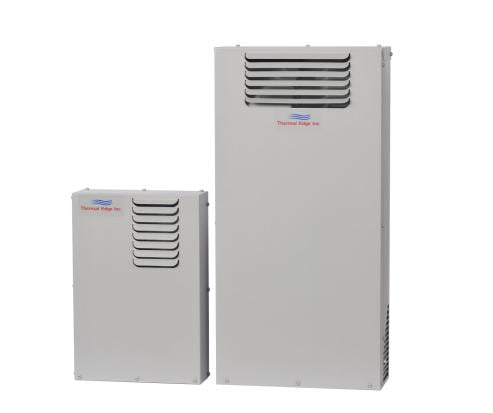Why it Pays to Use Air to Air Heat Exchangers
 In the world of industrial cabinet cooling, air to air heat exchangers may seem like the odd duck. Most engineers, designers and plant operators know that filtered fans or air conditioners can be great solutions to maintaining cool temperatures in electrical enclosures, but many may not understand the unique benefits of air to air heat exchangers, including the significant cost savings.
In the world of industrial cabinet cooling, air to air heat exchangers may seem like the odd duck. Most engineers, designers and plant operators know that filtered fans or air conditioners can be great solutions to maintaining cool temperatures in electrical enclosures, but many may not understand the unique benefits of air to air heat exchangers, including the significant cost savings.
Electrical and electronic components, such as PLCs, drives, starters and power supplies give off waste heat as they operate. But when confined in industrial enclosures, they are enveloped in this excess heat—along with the heat from ambient temperatures, insolation, and nearby heat generating equipment like ovens or boilers.
This excess heat may cause the components to exceed their maximum operating temperatures, as defined by the manufacturer, and they can begin lose efficiency, malfunction, and ultimately may fail, leading to unplanned replacement costs and expensive downtime.
Open loop vs. closed loop
To prevent these unnecessary costs, designers can specify either open loop or closed loop enclosure cooling systems. Open loop cooling, such as filtered fan systems, draws ambient air into the enclosure so that it passes over the surface of the components in order to remove heat directly. Even with filters in place, this can introduce dust, dirt, moisture, and chemical contaminants which may wreak havoc on valuable equipment.
To protect components in harsh operating environments, NEMA 4, NEMA 4X and some NEMA 12 enclosures require closed loop cooling systems, such as enclosure air conditioners or air to air heat exchangers, rather than filtered fan systems.
In closed loop cooling systems, the ambient air and potential contaminants never reach the inside of the sealed enclosure. Instead, cooling takes place with the help of a refrigerant, which is a chemical that converts easily from a liquid to a vapor and back again.
Unlike air conditioners, which require a motorized compressor, air to air heat exchangers use passive heat pipe technology to remove heat from an enclosure and discharge it to the ambient air. The heat pipe is a sealed copper tube clad with aluminum fins that aid heat transfer. The tube is partially evacuated and filled with a small amount of refrigerant that boils when exposed to the heated air from inside the enclosure.
As the refrigerant boils, it absorbs heat, cooling the lower end of the pipe. Following the natural law of convection, the boiling refrigerant vapor rises to the top of the heat pipe, where it condenses, giving up its heat as it is cooled by the cooler ambient air, and flows back to the bottom.
Lower cost, more energy efficient
This continuous heat pipe cooling requires no pumps or motors, and the rate of heat transfer simply depends on the temperature difference between the enclosure and the ambient air. The small energy cost comes from two small air circulation fans which move the enclosure air and the ambient air across the pipe.
Because circulation fans are the only moving parts, heat exchangers are a more cost efficient method of cooling an enclosure than air conditioners. Their low power requirements make these units ideal for locations where electricity is limited, and they can be easily powered by a small solar panel.
There is one catch, which is that heat exchangers can only be used where the ambient temperature remains below the maximum operating air temperature for the equipment. This is because the heat pipe can’t reduce the temperature below the temperature of the ambient air.
In situations where the ambient temperature is higher than the maximum allowable temperature enclosure air temperature, an air conditioner will be required. An online enclosure temperature management calculator can help determine whether an air to air heat exchanger can be used, or whether an air conditioner will be required for the enclosure.
For help in deciding whether an air to air heat exchanger will save money and energy, while protecting valuable components in an enclosure, contact the experts at Thermal Edge.

